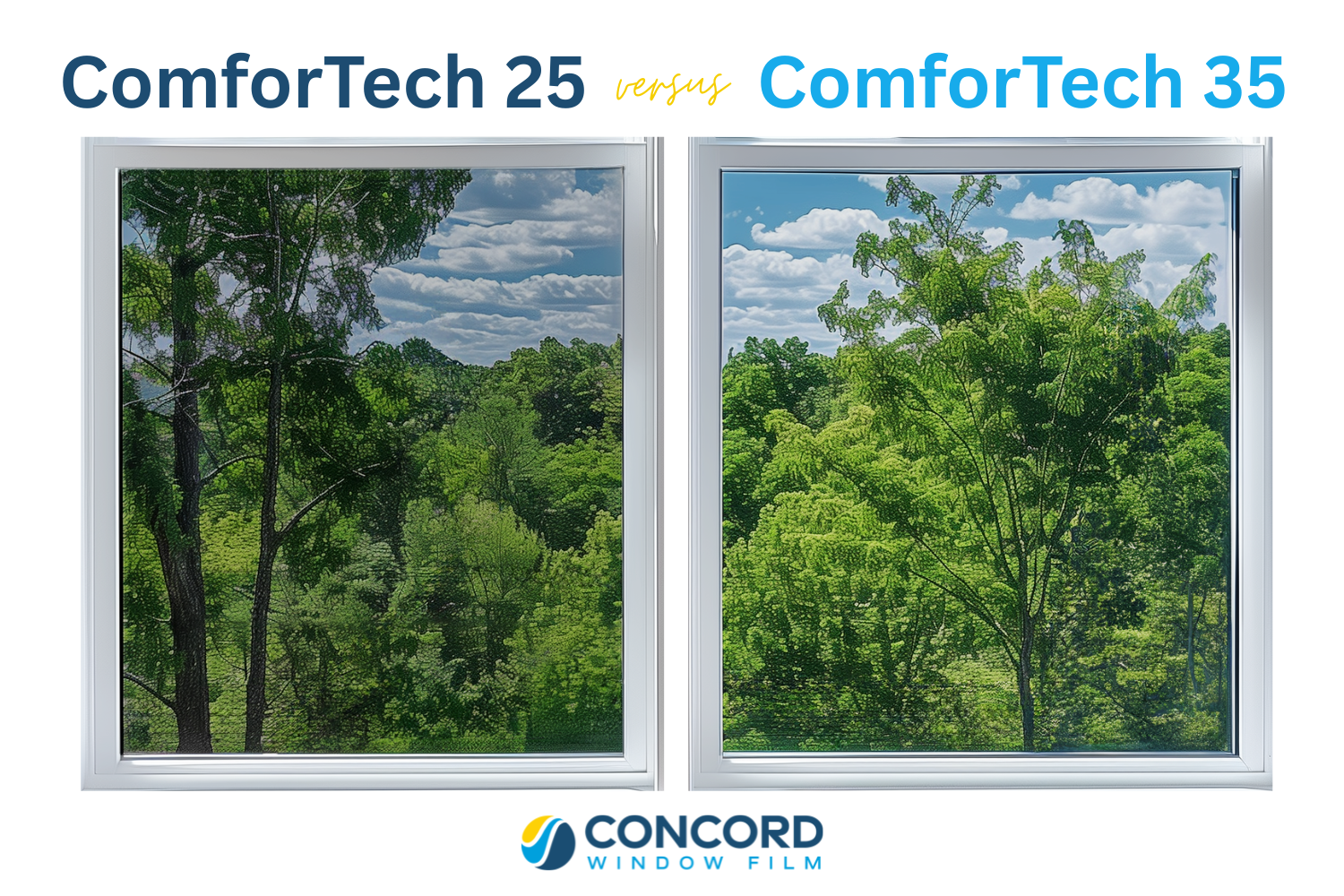
FREE SHIPPING ON PRECUT KIT ORDERS OF $100 OR MORE

In our digitally-driven world, eye strain has become a common complaint among people of all ages. Understanding the causes of eye strain and finding effective solutions is essential for maintaining eye health and overall well-being. In this article, we’ll explore the common causes of eye strain and introduce an innovative solution – the ComforTech Ceramic Series solar control film from Concord Window Film.
Eye strain can result from several factors, most notably:
Prolonged use of computers, tablets, and smartphones is a primary cause. These devices emit blue light, which can cause eye fatigue and discomfort.
Working in poorly lit environments or under harsh artificial lighting can strain your eyes.
Bright light and glare, especially from windows or intense indoor lighting, can lead to squinting and subsequent eye strain.
Not taking regular breaks during prolonged periods of focus, like reading or screen time, contributes significantly to eye fatigue.
While the ubiquitous use of digital devices today has definitely put a strain on our eyes, there are things you can do to reduce the damage.
Every 20 minutes, take a 20-second break and focus on something 20 feet away to give your eyes a break from close-up work (American Optometric Association). This simple practice helps relax the eye muscles.
Ensure your work and living spaces are well-lit but not overly bright. Use softer, diffused lighting to reduce glare and harsh shadows.
Adjusting lighting to minimize eye strain involves a combination of managing both natural and artificial light sources to create a comfortable, well-lit environment. Here are some strategies:
Use window film, blinds, or curtains to reduce direct sunlight, which can cause glare and make it difficult to see your screen.
Position your workspace perpendicular to windows to avoid direct sunlight on your screen or in your eyes.
Use adjustable desk lamps for focused tasks. These allow you to direct light exactly where you need it, reducing the need to strain your eyes.
Choose bulbs that offer a comfortable level of brightness and are not too harsh. LED bulbs that mimic natural light are often a good choice.
If possible, avoid overly bright overhead lights. Bright overhead lighting can cause glare, especially on screens.
Use a combination of ambient and task lighting to create a balanced lighting environment.
Position your computer screen to avoid reflections from windows or bright lights. Consider using an anti-glare screen on your monitor if glare is a persistent problem.
Adjust the brightness of your screen to match the level of light in your room. The screen should not be significantly brighter or darker than your surrounding environment.
Increase the contrast on your screen to reduce eye strain. Higher contrast can make text and images more distinguishable and easier on the eyes.
Warm light (yellowish) is generally better in the evening as it has less blue light, which can interfere with sleep cycles.
During the day, cooler light (bluish) mimics natural daylight and can help keep you alert.
Keep your screen clean. Dust and fingerprints can reduce clarity and increase glare and eye strain.
Walls painted in softer, matte colors can reduce glare and reflection. Bright or glossy wall paints can contribute to glare and visual fatigue.
Remember, the goal is to create a balanced environment where your eyes are not continually adjusting to varied light levels. This helps in reducing eye strain significantly.
Be conscious of the time spent on digital devices. Try to reduce unnecessary screen time, especially before bed, to minimize blue light exposure.
The recommended amount of screen time per day to reduce eye strain can vary depending on the individual’s age, lifestyle, and the nature of their work or daily activities. However, there are some general guidelines provided by health and vision experts:
There isn’t a one-size-fits-all recommendation for adults, as many jobs require prolonged computer use. The American Optometric Association (AOA) suggests following the 20-20-20 rule to minimize eye strain: every 20 minutes, take a 20-second break to look at something 20 feet away. This helps to reduce the risk of digital eye strain.
The American Academy of Pediatrics (AAP) recommends avoiding prolonged screen time for children. For children aged 2 to 5 years, screen time should be limited to one hour per day of high-quality programming. For children 6 years and older, consistent limits on the time spent using media and the types of media are crucial. They also emphasize the importance of ensuring media does not interfere with adequate sleep, physical activity, and other behaviors essential to health.
It’s advised to take regular breaks, adjust the lighting and contrast of your screen, and maintain an ergonomic posture while using digital devices. This applies to both adults and children.
Ensure that leisure time is balanced with activities that involve physical movement and are away from screens.
If prescribed, wear glasses specifically designed for computer use. These can help reduce glare and filter blue light.
Ensuring you wear the correct eyewear, particularly if you require prescription glasses, is crucial in reducing eye strain, especially during prolonged periods of screen use. According to the American Optometric Association (AOA), individuals who need glasses or contact lenses should ensure their prescription is up-to-date and suitable for looking at a computer screen.
Glasses designed specifically for computer use can be beneficial. They often have lenses that help reduce glare, block harmful blue light, and improve contrast, which makes it easier to look at a screen for extended periods.
The Vision Council also emphasizes the importance of considering lens options that can filter out blue light from computers and other digital devices, as prolonged exposure to this light can contribute to digital eye strain. These specialized lenses can also have anti-reflective coatings to reduce glare and increase contrast, further enhancing visual comfort and reducing potential eye strain.
It’s important to have regular eye examinations and discuss your screen usage with your eye care professional. They can offer personalized advice and recommend appropriate eyewear based on your specific needs, considering factors such as your typical screen viewing distance and the lighting conditions in your work or study environment.
Position your screen at an appropriate distance. The appropriate distance for positioning a laptop or computer screen from your eyes is typically about an arm’s length away. More specifically, the screen should be about 20 to 28 inches (50 to 70 cm) from your eyes. This distance is generally considered optimal for maintaining a comfortable posture and reducing eye strain.
In addition to distance, it’s also important to consider the height of the monitor. The top of the screen should be at or slightly below eye level. This positioning ensures that you’re looking slightly downward when viewing the middle of the screen. Such an angle is considered ergonomic as it helps reduce the strain on your eyes and neck.
Remember, these recommendations can vary slightly depending on personal comfort, the size of the screen, and individual vision needs. It’s essential to adjust your workspace according to what feels most comfortable for you while also minimizing strain on your eyes, neck, and back.
Incorporating eye exercises into your daily routine to strengthen eye muscles and improve focus flexibility can significantly reduce eye strain. Here are some effective exercises, as recommended by health experts:
Rub your hands together to generate warmth, then gently cup them over your closed eyes without applying pressure. The warmth and darkness will soothe your eyes (Mayo Clinic).
Hold a finger a few inches away from your eye. Focus on your finger, then slowly move it away while maintaining focus. Shift your focus to something farther away, then back to your finger, and slowly bring it back toward your eye (American Academy of Ophthalmology).
Sit up straight and relax your shoulders. Look up and then slowly circle your eyes in a clockwise direction, then anticlockwise. Repeat this a few times (Healthline).
Blink rapidly for a few seconds. This helps refresh the eyes and clears any dust or irritants (WebMD).
In addition to these strategies, incorporating Concord Window Film’s ComforTech™ Ceramic Series into your home or office can be a game-changer. This state-of-the-art solar control film offers several benefits:
By significantly reducing the glare from sunlight, the ComforTech™ Ceramic Series helps create a more comfortable environment for your eyes, especially in rooms with screens.
The film blocks 99% of harmful UV rays in the 300-380nm spectrum, protecting your eyes and skin, and preventing the fading of furniture and flooring.
This film helps maintain a consistent indoor temperature, reducing the strain on your eyes caused by fluctuating light and heat levels.
By keeping your space cooler in summer, ComforTech™ Ceramic Series film can also lead to lower energy bills by reducing your need for running your AC.
One of the best aspects of Concord Window Film’s products is their ease of DIY installation. Homeowners looking for professional-grade solutions they can install themselves will find this feature particularly appealing. The window film installation process is straightforward, and the films are designed to be durable and long-lasting.
Eye strain is a growing concern in our screen-dominated lives. By understanding its causes and implementing effective solutions like regular breaks, proper lighting, and using protective eyewear, you can significantly reduce its impact. Additionally, integrating Concord Window Film’s ComforTech™ Ceramic Series into your living or workspace can provide an extra layer of protection and comfort, contributing to healthier, strain-free eyes. Remember, taking care of your eyes today is an investment in your overall health for the future.